Effective Prediction of Concrete Constitutive Models for Reinforced Concrete Shear Walls under Cyclic Loading
Abstract
1. Introduction
1.1. Background
1.2. Research Purpose
2. Constitutive Modeling of Concrete
2.1. The KCC Model (MAT072R3)
2.2. The CDP Model (MAT273)
2.3. The Winfrith Model (MAT085)
3. Analytical Methodology Validation
3.1. Experimental Investigation
3.2. Constitutive Models of Materials
3.3. Contact and Boundary Conditions
4. Experimentation-Based Numerical Analysis and Comparison
4.1. Evaluation of 2D Walls under Cyclic Loading
4.1.1. Backbone Curves and Hysteresis
4.1.2. Behaviour of Failure
4.2. Evaluation of 3D Walls under Cyclic Loading
4.2.1. Backbone Curves and Hysteresis
4.2.2. Behaviour of Failure
5. Parametric Studies
5.1. Effectiveness of Concrete Compressive Strength ()
5.2. Strain Rate Effects
5.3. Mesh-Size Effects
5.4. Concrete Element Effects
6. Conclusions
- 1.
- Among the three material models examined in this study, the KCC model accurately projected the cyclic performance of both the flexural and shear components, including the deterioration of strength and stiffness for the 2D wall. The KCC model exhibited lower efficacy compared to the CDP and Winfrith models in predicting the degradation of peak strength and stiffness in the 3D wall. Both models, the Winfrith model and the examined components, showed reasonable results in predicting the peak strength, stiffness deterioration, and energy dissipation. In summary, the Winfrith model proved to be the most dependable for analysing the behaviour of shear walls. Therefore, it is recommended to limit the use of the KCC and CDP models when simulating the reaction of shear walls.
- 2.
- The failure mode of the examined components, which was accurately predicted by the CDP and Winfrith models, involved the crushing of concrete. The places experiencing the highest tensile stress were identified using fringes indicating maximum tensile strain. The destruction of concrete was demonstrated by removing elements once they met the erosion criterion. The maximum principal strain contours of the KCC, CDP, and Winfrith models can identify the areas with the highest flexural stresses in beams.
- 3.
- The CDP and Winfrith models were similar regarding the improvement of the force-resistance of 2D and 3D walls when varying the concrete strength. The strain rate had a significant effect on seismic response in which the RATE = 1 was appropriate for RC walls. Even though the mesh size and element type had a negligible effect on peak strength and pinching effects, they significantly affected the time analysis of the model. Hence, the optimal choice for the numerical simulation was a mesh size of 25 mm and an element type of ELFORM = 1.
- 4.
- In light of the findings from this study, the authors intend to utilise the Winfrith and CDP concrete models in future investigations to examine the behaviour of several shapes of reinforced concrete (RC) walls, including L, T, and I shapes. These particular designs were chosen due to their widespread application in contemporary building practices. However, this research has a limitation in that it ignores the friction ratio in the bonding between rebars and concrete. Instead, it replaces it with a contact function in the LS-DYNA software throughout the simulation process. This will be improved and taken into account in further investigations.
Author Contributions
Funding
Institutional Review Board Statement
Informed Consent Statement
Data Availability Statement
Conflicts of Interest
References
- Bischoff, P.H.; Perry, S. Compressive behaviour of concrete at high strain rates. Mater. Struct. 1991, 24, 425–450. [Google Scholar] [CrossRef]
- Kong, X.; Fang, Q.; Chen, L.; Wu, H. A new material model for concrete subjected to intense dynamic loadings. Int. J. Impact Eng. 2018, 120, 60–78. [Google Scholar] [CrossRef]
- Wang, B.; Wu, M.Z.; Shi, Q.X.; Cai, W.Z. Seismic performance of flanged RC walls under biaxial cyclic loading. J. Build. Eng. 2023, 64, 105632. [Google Scholar] [CrossRef]
- Teng, J.; Xiao, Q.; Yu, T.; Lam, L. Three-dimensional finite element analysis of reinforced concrete columns with FRP and/or steel confinement. Eng. Struct. 2015, 97, 15–28. [Google Scholar] [CrossRef]
- Bao, Y.; Lew, H.S.; Kunnath, S.K. Modeling of reinforced concrete assemblies under column-removal scenario. J. Struct. Eng. 2014, 140, 04013026. [Google Scholar] [CrossRef]
- Ghaseminia, S.M.; Zahra, T.; Thambiratnam, D.P.; Thamboo, J. Response of RC shear walls with single and double layers of reinforcements subjected to in-plane cyclic loading. Structures 2023, 56, 105005. [Google Scholar] [CrossRef]
- Markovich, N.; Kochavi, E.; Ben-Dor, G. An improved calibration of the concrete damage model. Finite Elem. Anal. Des. 2011, 47, 1280–1290. [Google Scholar] [CrossRef]
- Aaleti, S.; Sritharan, S. A simplified analysis method for characterizing unbonded post-tensioned precast wall systems. Eng. Struct. 2009, 31, 2966–2975. [Google Scholar] [CrossRef]
- Abdoos, H.; Khaloo, A. Failure mechanism of a curved RC shear wall subjected to cyclic loading: Experimental findings. Eng. Struct. 2024, 304, 117703. [Google Scholar] [CrossRef]
- Tang, Y.C.; Li, H.N.; Li, C. Parametric studies on seismic performance of new precast braced concrete shear walls under cyclic loading. J. Struct. Eng. 2023, 149, 04023061. [Google Scholar] [CrossRef]
- Bastami, M.; Salehi, M.; Ghorbani, M.; Moghadam, A.S. Performance of special RC shear walls under lateral cyclic and axial loads. Eng. Struct. 2023, 295, 116813. [Google Scholar] [CrossRef]
- Hallquist, J.O. LS-DYNA Keyword User’s Manual; Livermore Software Technology Corporation: Livermore, CA, USA, 2007; Volume 970, pp. 299–800. [Google Scholar]
- Riedel, W. 10 years RHT: A review of concrete modelling and hydrocode applications. In Predictive Modeling of Dynamic Processes; Springer: Berlin/Heidelberg, Germany, 2009; pp. 143–165. [Google Scholar]
- Xu, J.; Lu, Y. A comparative study of modelling RC slab response to blast loading with two typical concrete material models. Int. J. Prot. Struct. 2013, 4, 415–432. [Google Scholar] [CrossRef]
- Zhang, C.; Abedini, M.; Mehrmashhadi, J. Development of pressure-impulse models and residual capacity assessment of RC columns using high fidelity Arbitrary Lagrangian-Eulerian simulation. Eng. Struct. 2020, 224, 111219. [Google Scholar] [CrossRef]
- Abedini, M.; Zhang, C. Performance assessment of concrete and steel material models in ls-dyna for enhanced numerical simulation, a state of the art review. Arch. Comput. Methods Eng. 2021, 28, 2921–2942. [Google Scholar] [CrossRef]
- Mutalib, A.A.; Tawil, N.M.; Baharom, S.; Abedini, M. Failure probabilities of FRP strengthened RC column to blast loads. J. Teknol. 2013, 65, 135–141. [Google Scholar] [CrossRef]
- Asgarpoor, M.; Gharavi, A.; Epackachi, S. Investigation of various concrete materials to simulate seismic response of RC structures. Structures 2021, 29, 1322–1351. [Google Scholar] [CrossRef]
- Mussa, M.H.; Mutalib, A.A.; Hamid, R.; Naidu, S.R.; Radzi, N.A.M.; Abedini, M. Assessment of damage to an underground box tunnel by a surface explosion. Tunn. Undergr. Sp. Technol. 2017, 66, 64–76. [Google Scholar] [CrossRef]
- Murray, Y.D. Manual for LS-DYNA Wood Material Model 143; Technical Report; United States Federal Highway Administration: McLean, VA, USA, 2007.
- Mehrabi, A.B.; Shing, P.B. Finite element modeling of masonry-infilled RC frames. J. Struct. Eng. 1997, 123, 604–613. [Google Scholar] [CrossRef]
- Bao, Q.T.; Lee, K.; Kim, S.J.; Shin, J. Quantifying Effect of Post-Tensioned Bars for Precast Concrete Shear Walls. Sustainability 2022, 14, 6141. [Google Scholar] [CrossRef]
- Vásquez, J.A.; Jünemann, R.; de la Llera, J.C.; Hube, M.A.; Chacón, M.F. Three-dimensional nonlinear response history analyses for earthquake damage assessment: A reinforced concrete wall building case study. Earthq. Spectra 2021, 37, 235–261. [Google Scholar] [CrossRef]
- Palermo, D.; Vecchio, F.J. Compression field modeling of reinforced concrete subjected to reversed loading: Verification. ACI Struct. J. 2004, 101, 155–164. [Google Scholar]
- Kim, T.H.; Lee, K.M.; Chung, Y.S.; Shin, H. Seismic damage assessment of reinforced concrete bridge columns. Eng. Struct. 2005, 27, 576–592. [Google Scholar] [CrossRef]
- Koutromanos, I.; Stavridis, A.; Shing, P.B.; Willam, K. Numerical modeling of masonry-infilled RC frames subjected to seismic loads. Comput. Struct. 2011, 89, 1026–1037. [Google Scholar] [CrossRef]
- Zhang, Y.; Zhang, S.; Li, T.; Deng, M. Cyclic response and shear mechanisms of RC short walls strengthened with engineered cementitious composites thin layers. Arch. Civ. Mech. Eng. 2023, 23, 148. [Google Scholar] [CrossRef]
- Lin, X.; Zhang, Y.; Hazell, P.J. Modelling the response of reinforced concrete panels under blast loading. Mater. Des. 2014, 56, 620–628. [Google Scholar] [CrossRef]
- Zheng, Y.; Robinson, D.; Taylor, S.; Cleland, D. Finite element investigation of the structural behaviour of deck slabs in composite bridges. Eng. Struct. 2009, 31, 1762–1776. [Google Scholar] [CrossRef]
- Sasani, M.; Werner, A.; Kazemi, A. Bar fracture modeling in progressive collapse analysis of reinforced concrete structures. Eng. Struct. 2011, 33, 401–409. [Google Scholar] [CrossRef]
- Li, H.; Shi, G. Material modeling of concrete for the numerical simulation of steel plate reinforced concrete panels subjected to impacting loading. J. Eng. Mater. Technol. 2017, 139, 021011. [Google Scholar] [CrossRef]
- Hong, J.; Fang, Q.; Chen, L.; Kong, X. Numerical predictions of concrete slabs under contact explosion by modified K&C material model. Constr. Build. Mater. 2017, 155, 1013–1024. [Google Scholar]
- Xu, M.; Wille, K. Calibration of K&C concrete model for UHPC in LS-DYNA. Adv. Mater. Res. 2015, 1081, 254–259. [Google Scholar]
- Kong, X.; Fang, Q.; Li, Q.; Wu, H.; Crawford, J.E. Modified K&C model for cratering and scabbing of concrete slabs under projectile impact. Int. J. Impact Eng. 2017, 108, 217–228. [Google Scholar]
- Willam, K.J. Constitutive model for the triaxial behaviour of concrete. Proc. Int. Assoc. Bridge Struct. Eng. 1975, 19, 1–30. [Google Scholar]
- Crawford, J.; Wu, Y.; Choi, H.; Magallanes, J.; Lan, S. Use and Validation of the Release III K&C Concrete Material Model in LS-DYNA; Technical Report TR-11-36.5; Federal Highway Administration: Glendale, CA, USA, 2012.
- Malvar, L.J.; Crawford, J.E.; Wesevich, J.W.; Simons, D. A plasticity concrete material model for DYNA3D. Int. J. Impact Eng. 1997, 19, 847–873. [Google Scholar] [CrossRef]
- Schwer, L.E.; Malvar, L.J. Simplified Concrete Modeling with *MAT_CONCRETE_DAMAGE_REL3. JRI LS-Dyna User Week. 2005, pp. 49–60. Available online: https://ftp.lstc.com/anonymous/outgoing/support/FAQ_kw/concrete/mat_072r3.pdf (accessed on 15 April 2024).
- Mohammed, T.A.; Parvin, A. Evaluating damage scale model of concrete materials using test data. Adv. Concr. Constr. 2013, 1, 289. [Google Scholar] [CrossRef]
- Grassl, P.; Jirásek, M. Damage-plastic model for concrete failure. Int. J. Solids Struct. 2006, 43, 7166–7196. [Google Scholar] [CrossRef]
- Grassl, P.; Xenos, D.; Nyström, U.; Rempling, R.; Gylltoft, K. CDPM2: A damage-plasticity approach to modelling the failure of concrete. Int. J. Solids Struct. 2013, 50, 3805–3816. [Google Scholar] [CrossRef]
- Broadhouse, B.; Neilson, A. Modelling Reinforced Concrete Structures in DYNA3D; Technical Report; UKAEA Atomic Energy Establishment: Winfrith, UK, 1987.
- Ottosen, N.S. A failure criterion for concrete. J. Eng. Mech. Div. 1977, 103, 527–535. [Google Scholar] [CrossRef]
- CEB-FIP, C. Model Code 1990; Comite Euro-International Du Beton: Paris, France, 1991; pp. 87–109. [Google Scholar]
- Pakiding, L.; Pessiki, S.; Sause, R.; Rivera, M. Lateral load response of unbonded post-tensioned cast-in-place concrete walls. In Proceedings of the Structures Congress 2015, Portland, OR, USA, 23–25 April 2015; pp. 1338–1349. [Google Scholar]
- Beyer, K.; Dazio, A.; Priestley, M. Quasi-static cyclic tests of two U-shaped reinforced concrete walls. J. Earthq. Eng. 2008, 12, 1023–1053. [Google Scholar] [CrossRef]
- Hallquist, J. Recent developments in LS-DYNA. In Proceedings of the 7th European LS-DYNA Conference, Salzburg, Austria, 14–15 May 2009; pp. 1–52. [Google Scholar]
- Bhargawa, A.; Roddis, W.K.; Marzougui, D.; Mohan, P.K. Analysis of Extended End-Plate Connections under Cyclic Loading Using the LS-DYNA Implicit Solver. In Proceedings of the 9th International LS-DYNA Conference, DYNAlook, Detroit, MI, USA, 4–6 June 2006; pp. 4–6. [Google Scholar]
- Abedini, M.; Mutalib, A.A.; Raman, S.N.; Akhlaghi, E.; Mussa, M.H.; Ansari, M. Numerical investigation on the non-linear response of reinforced concrete (RC) columns subjected to extreme dynamic loads. J. Asian Sci. Res. 2017, 7, 86. [Google Scholar] [CrossRef][Green Version]
- Lu, G.; Li, X.; Wang, K. A numerical study on the damage of projectile impact on concrete targets. Comput. Concr. 2012, 9, 21–33. [Google Scholar] [CrossRef]
- Majidi, L.; Usefi, N.; Abbasnia, R. Numerical study of RC beams under various loading rates with LS-DYNA. J. Cent. South Univ. 2018, 25, 1226–1239. [Google Scholar] [CrossRef]
- Abedini, M.; Mutalib, A.A. Investigation into damage criterion and failure modes of RC structures when subjected to extreme dynamic loads. Arch. Comput. Methods Eng. 2020, 27, 501–515. [Google Scholar] [CrossRef]
- Gholipour, G.; Zhang, C.; Mousavi, A.A. Loading rate effects on the responses of simply supported RC beams subjected to the combination of impact and blast loads. Eng. Struct. 2019, 201, 109837. [Google Scholar] [CrossRef]
- Shin, J.; Jeon, J.S. Retrofit scheme of FRP jacketing system for blast damage mitigation of non-ductile RC building frames. Compos. Struct. 2019, 228, 111328. [Google Scholar] [CrossRef]
- Symans, M.D.; Charney, F.A.; Whittaker, A.; Constantinou, M.C.; Kircher, C.; Johnson, M.W.; McNamara, R.J. Energy dissipation systems for seismic applications: Current practice and recent developments. J. Struct. Eng. 2008, 134, 3–21. [Google Scholar] [CrossRef]
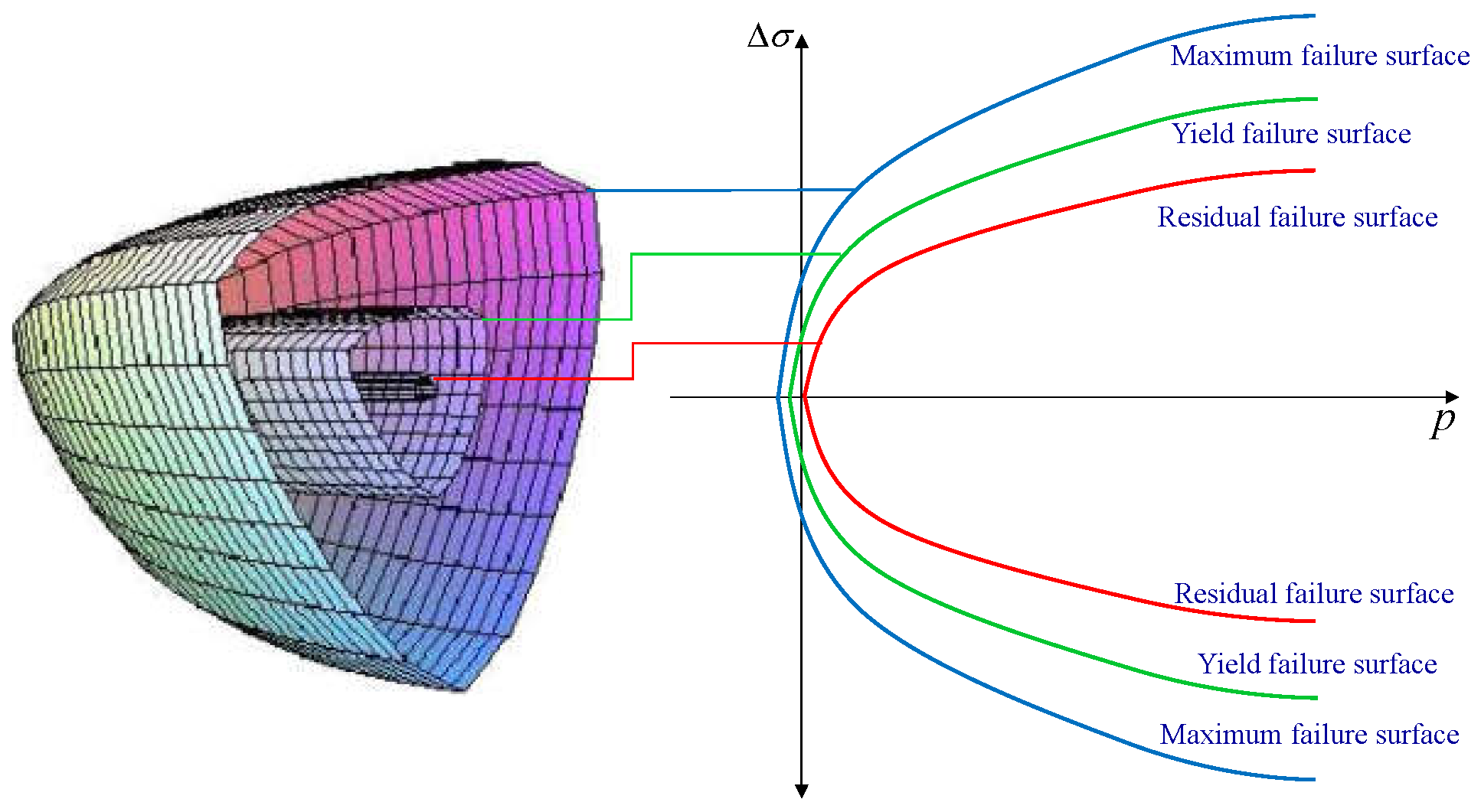
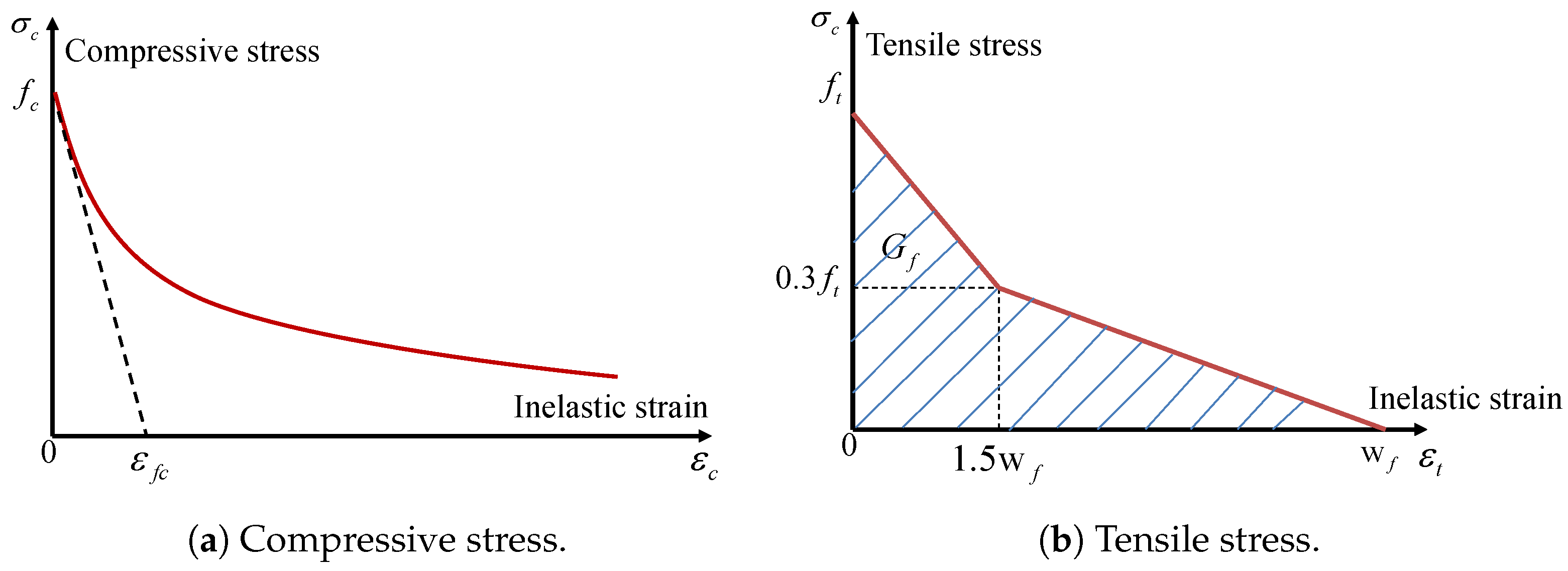
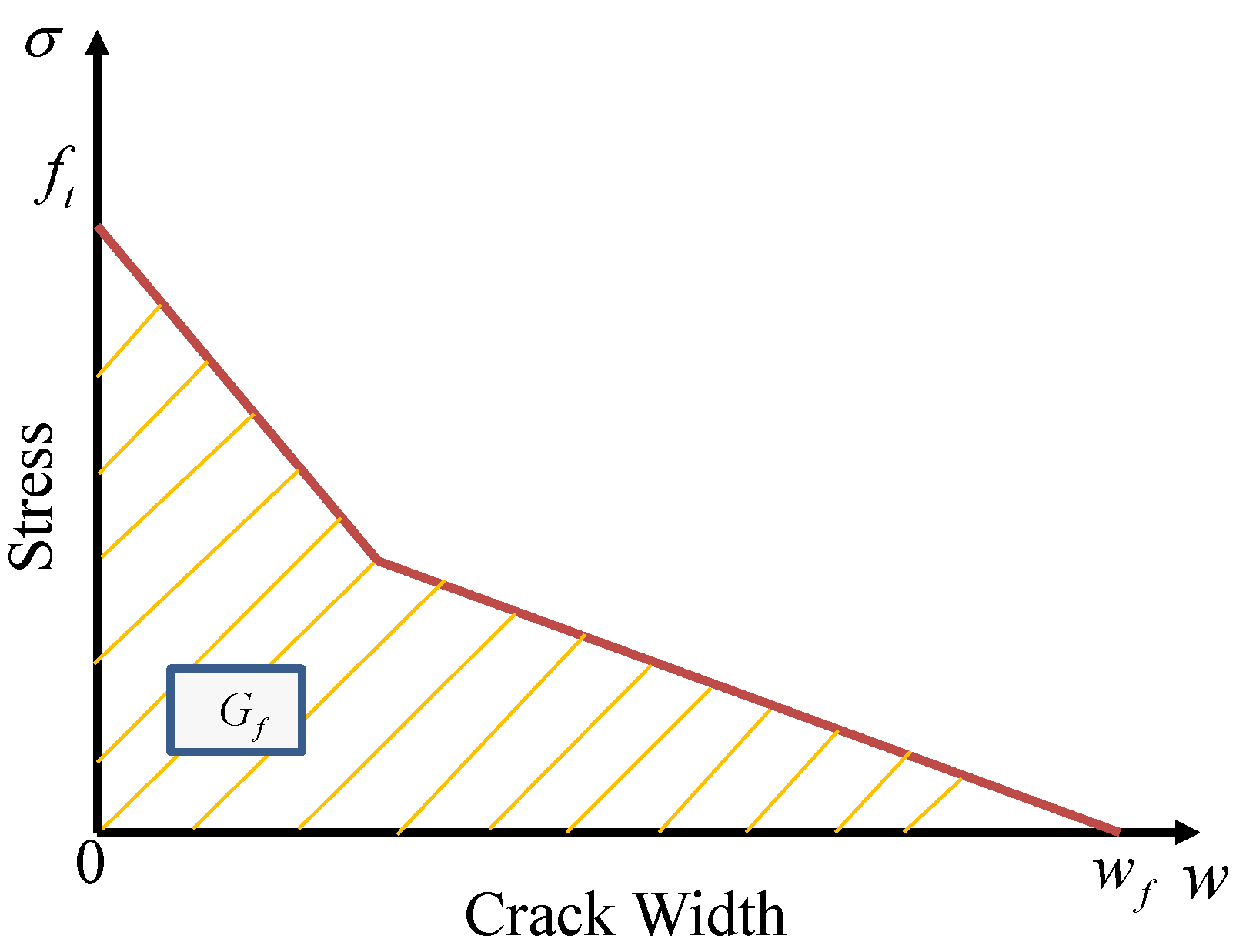
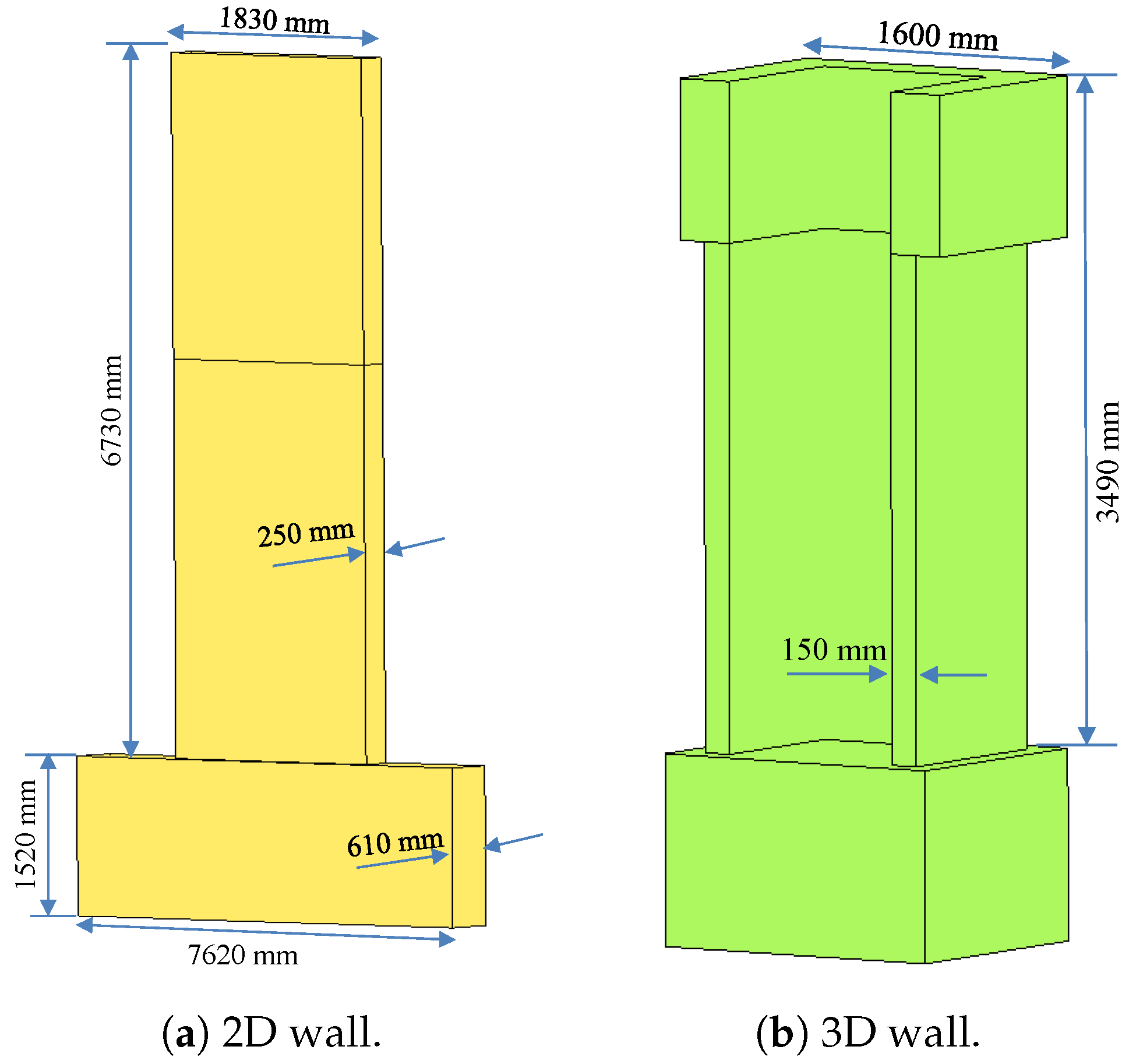
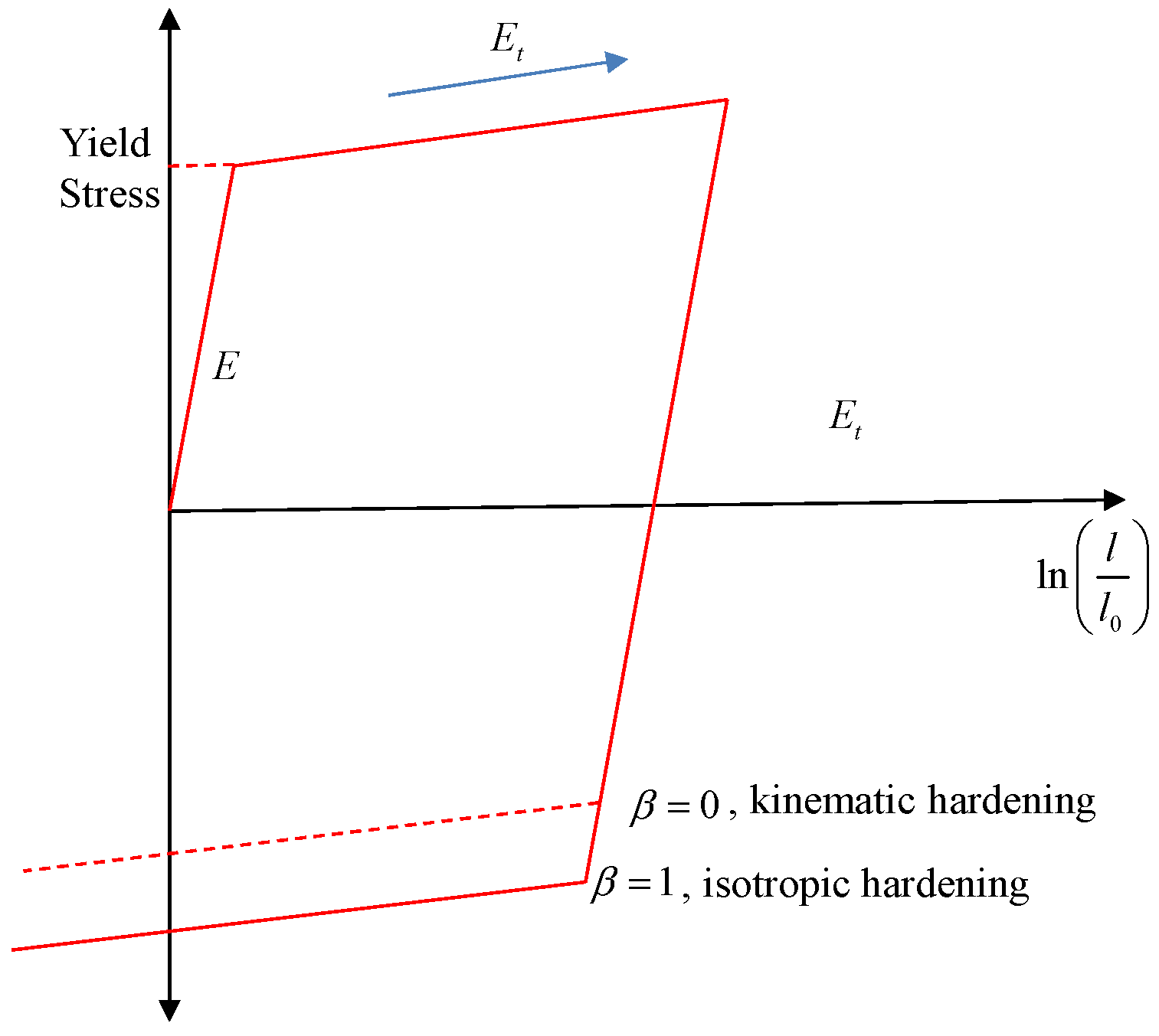
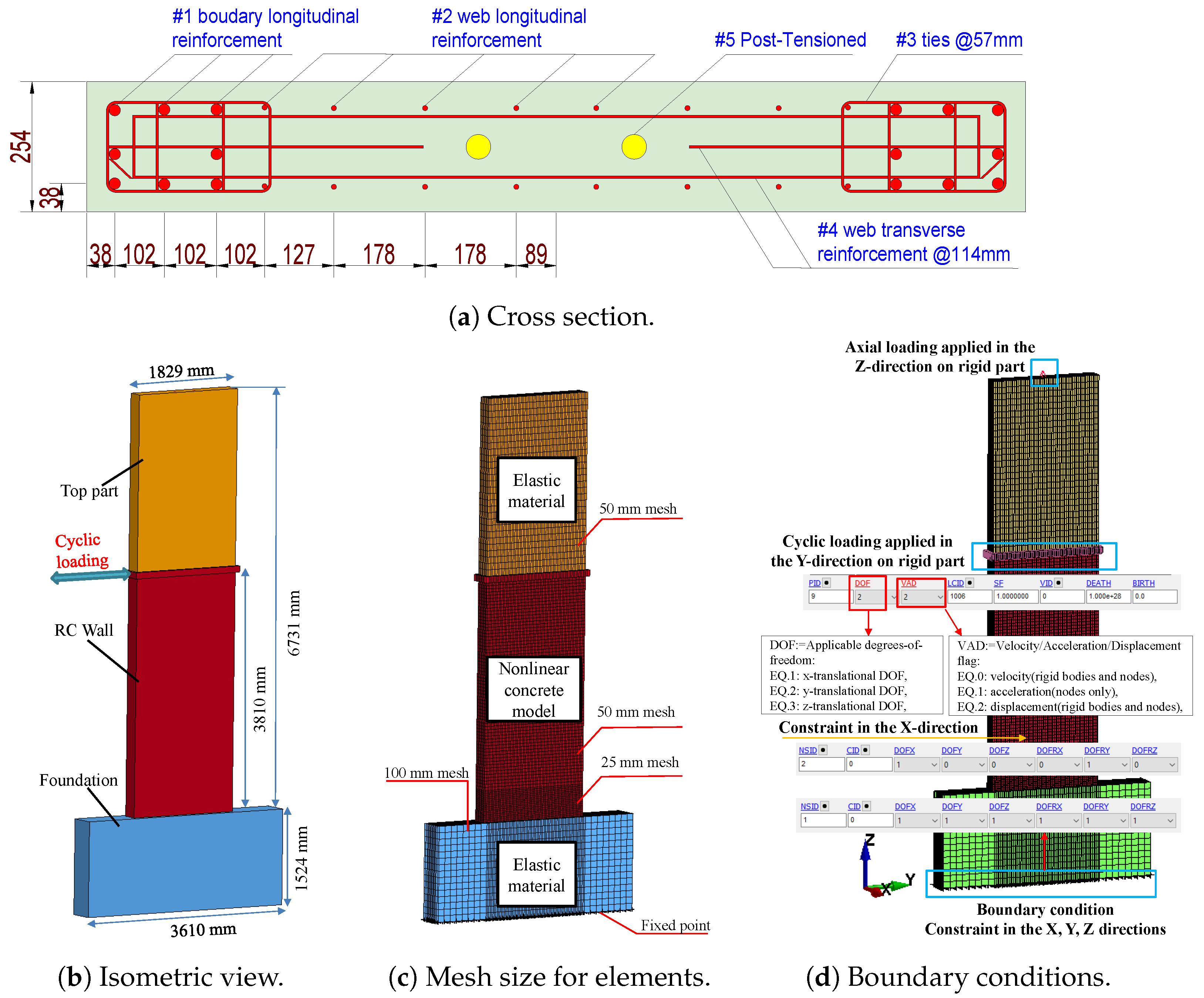
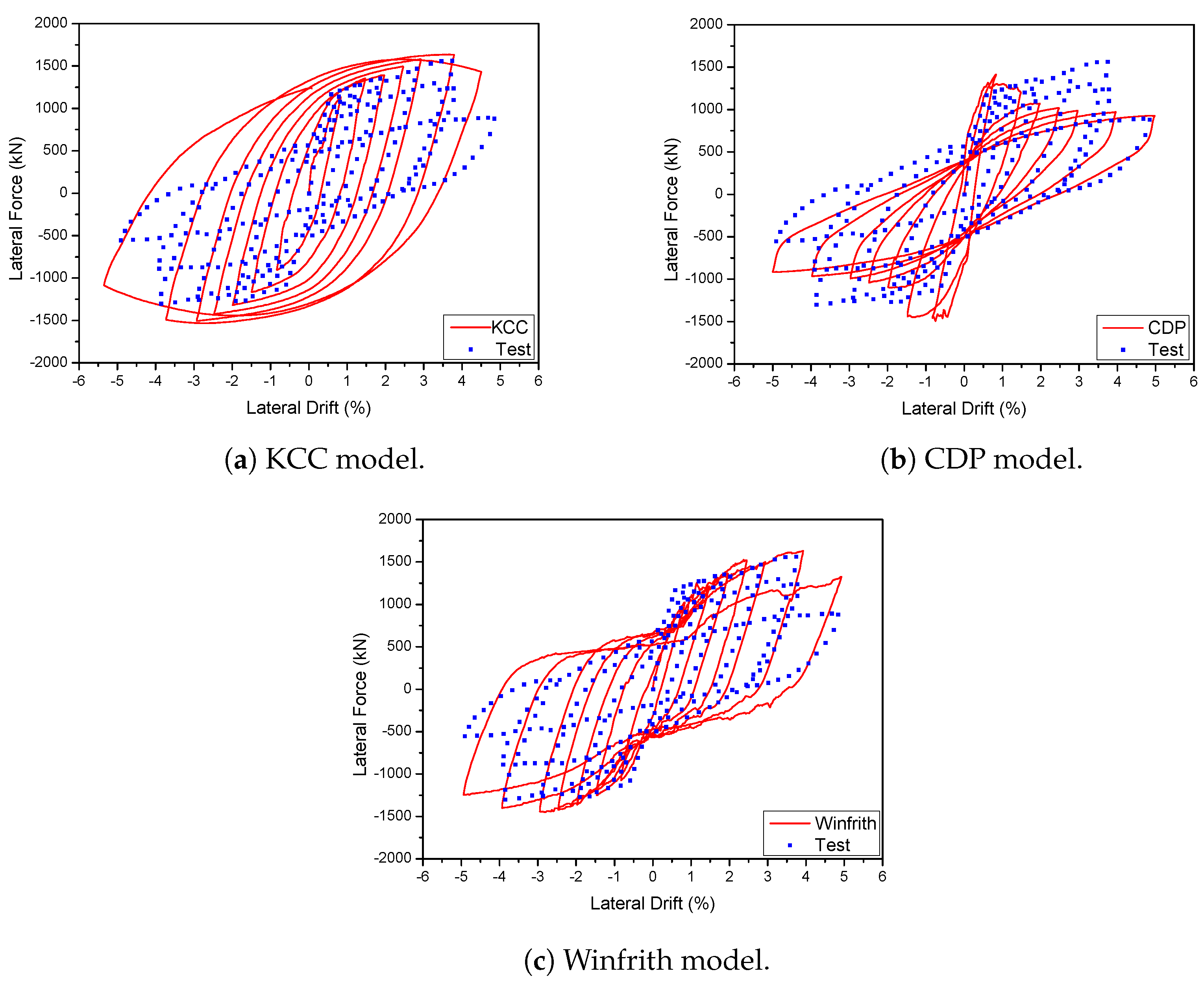

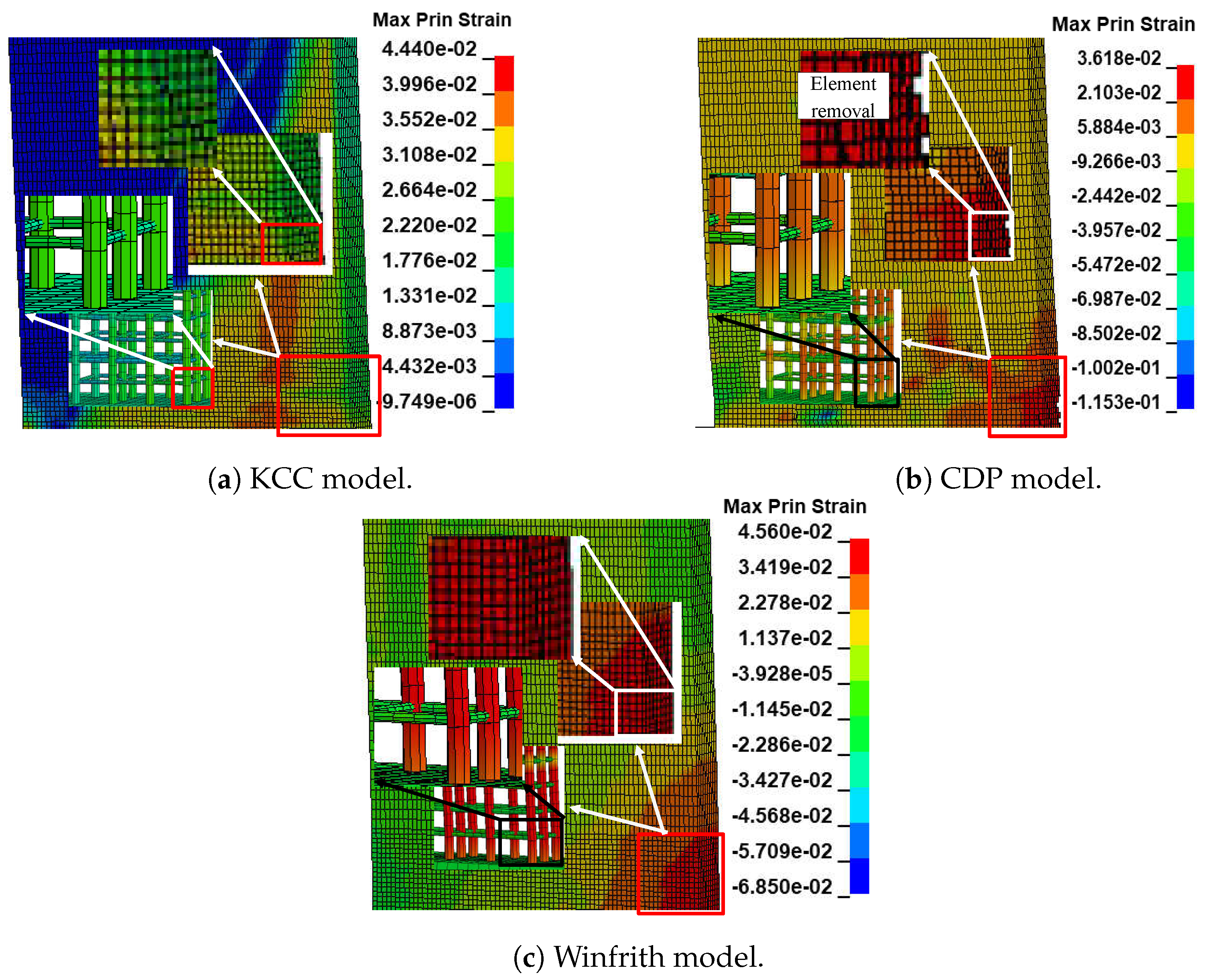
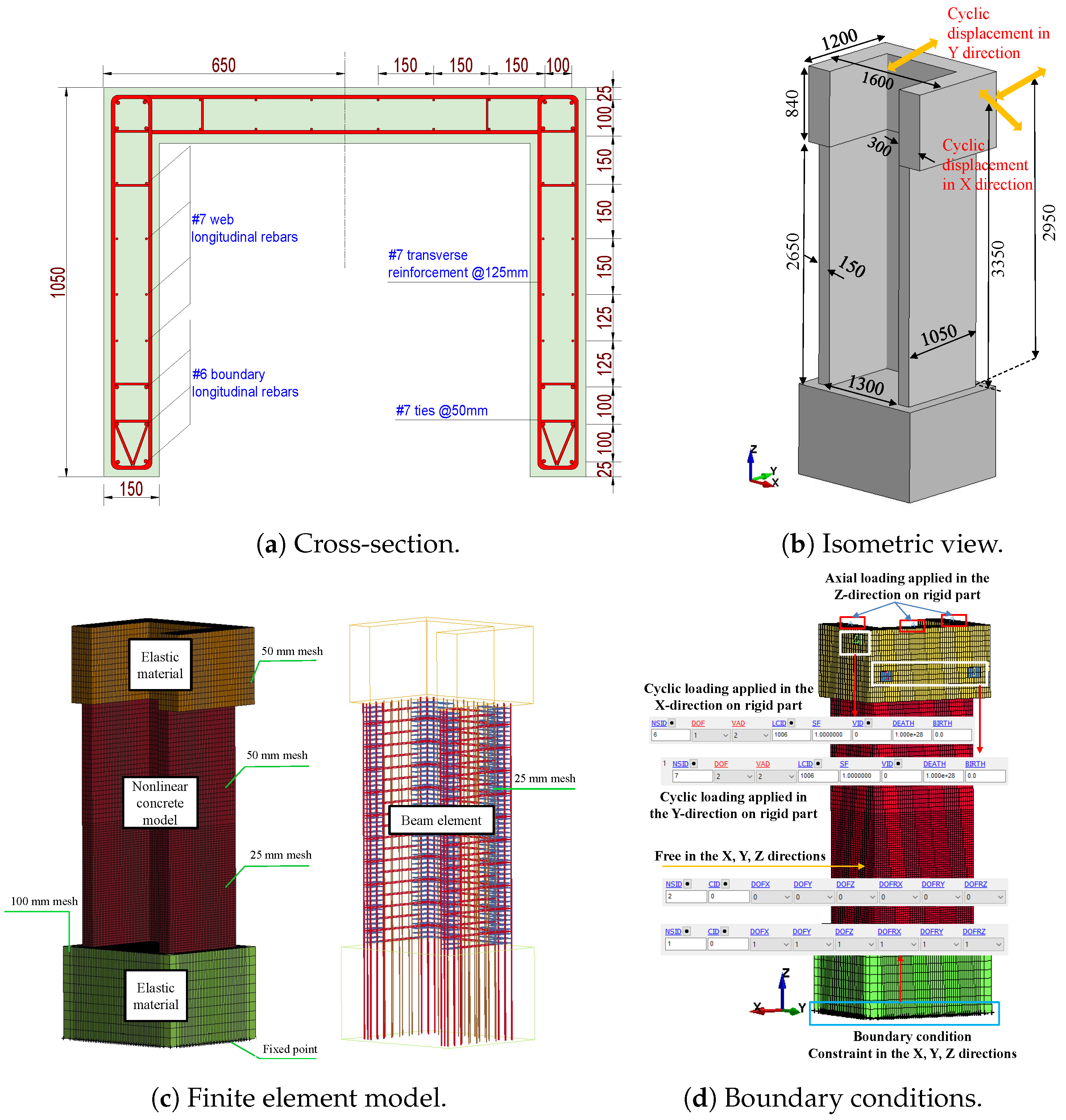
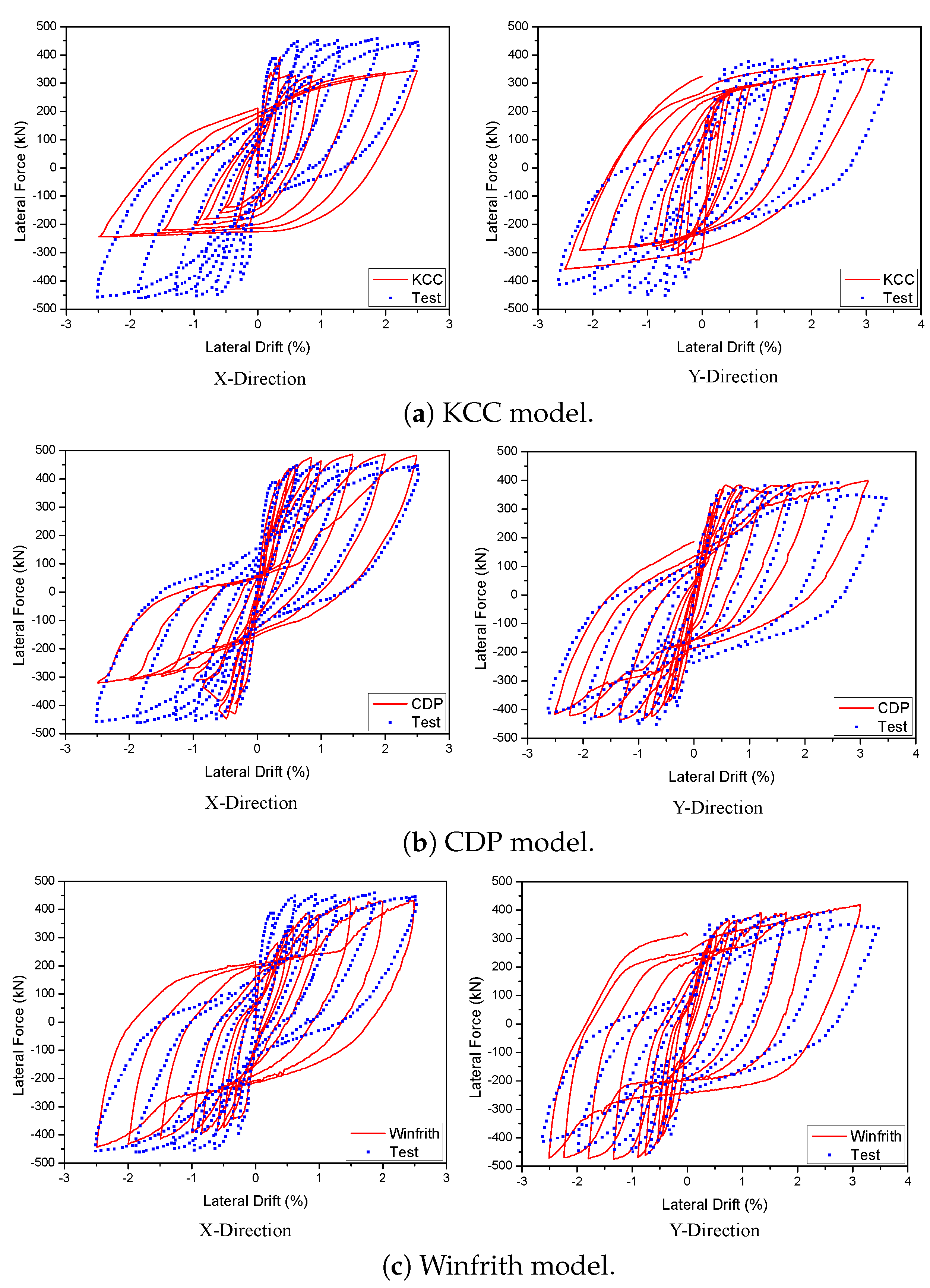
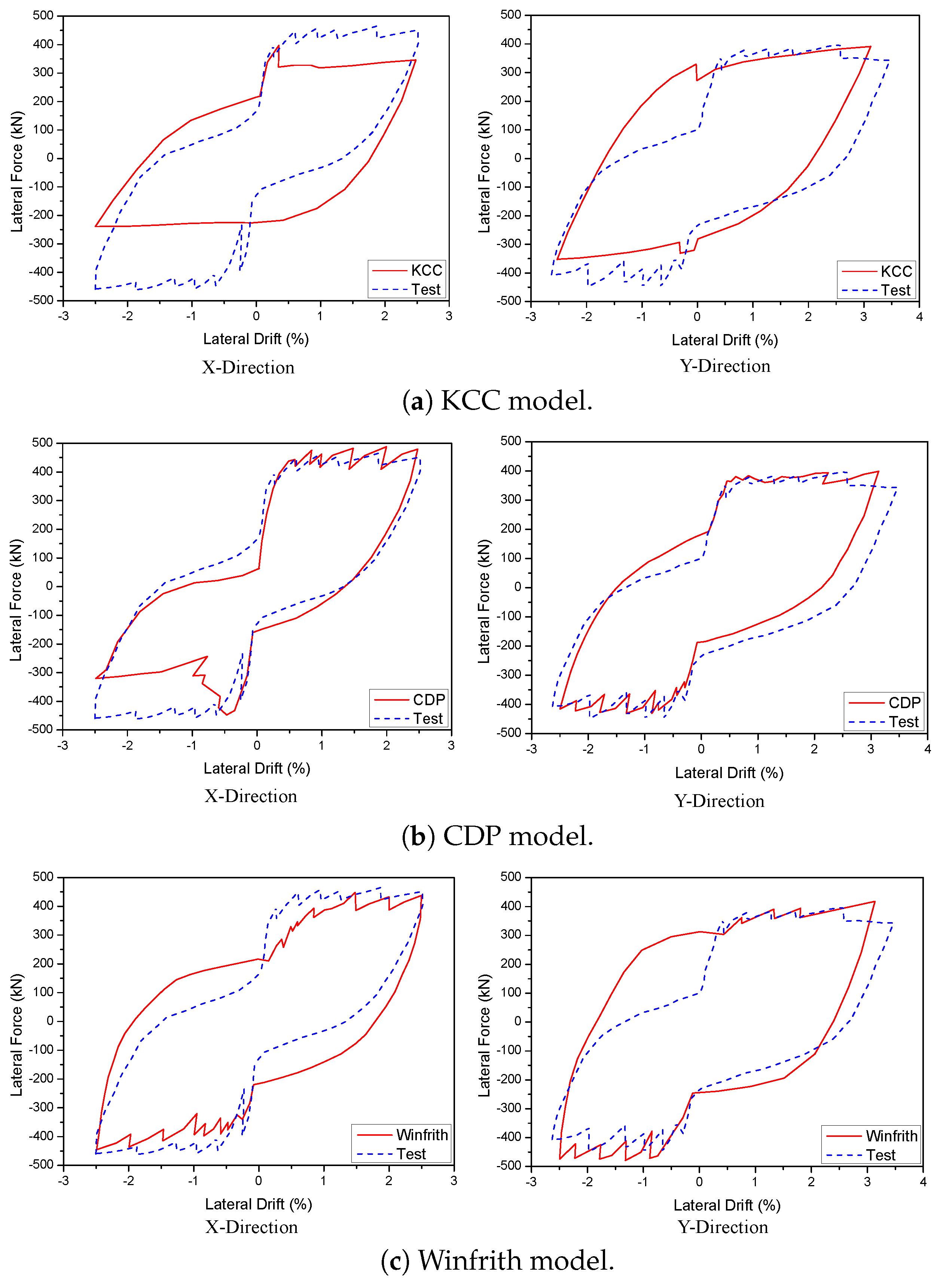
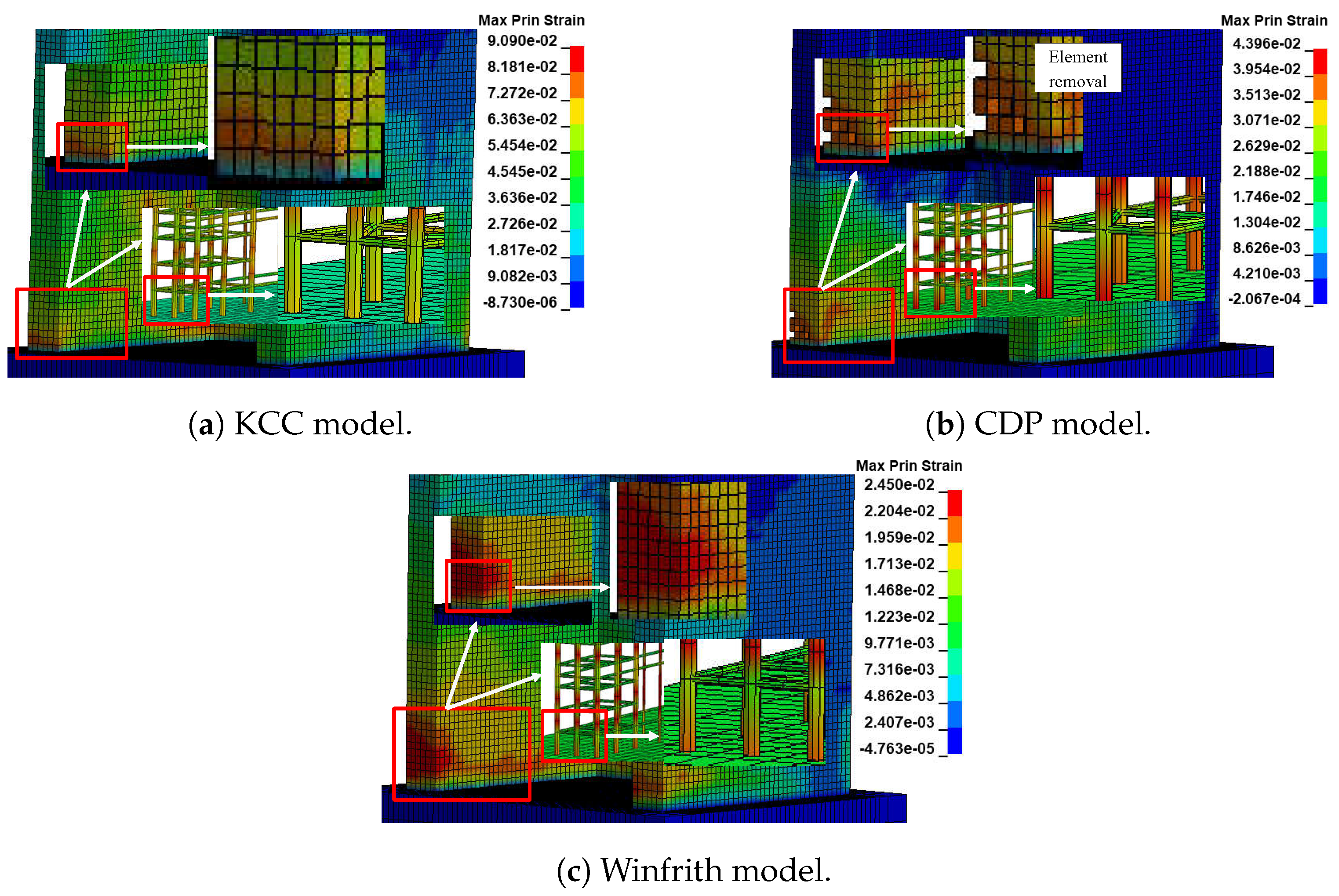
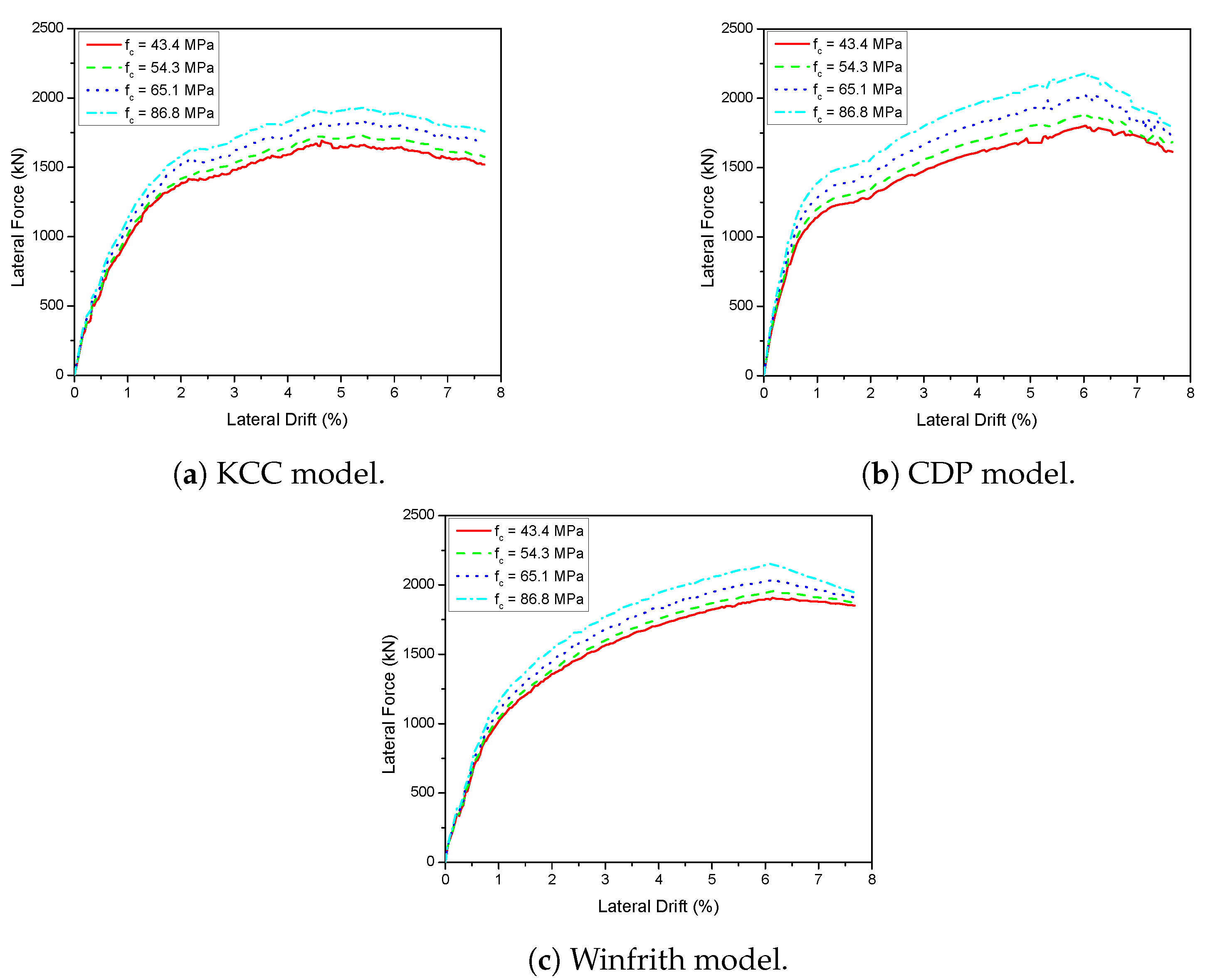
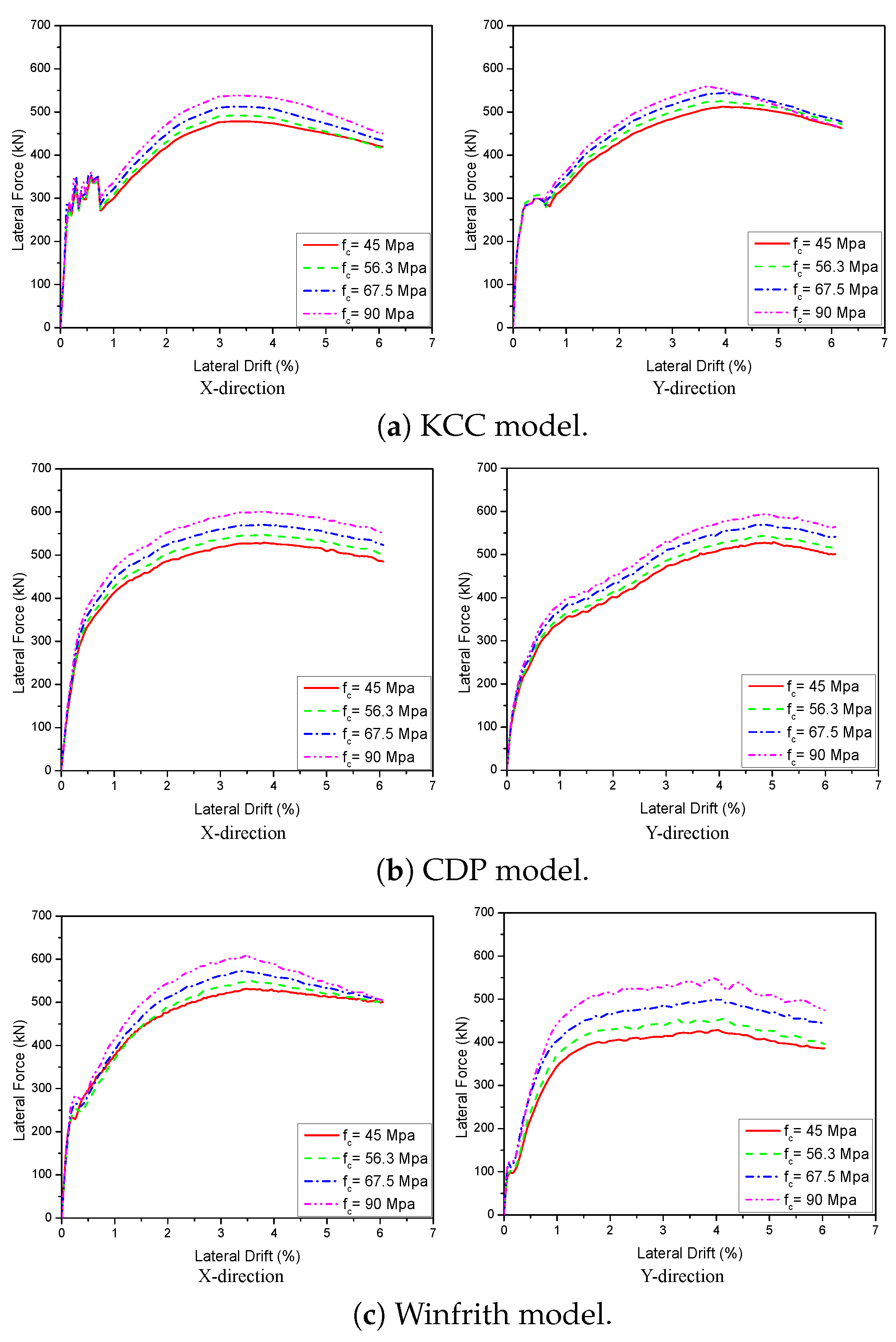
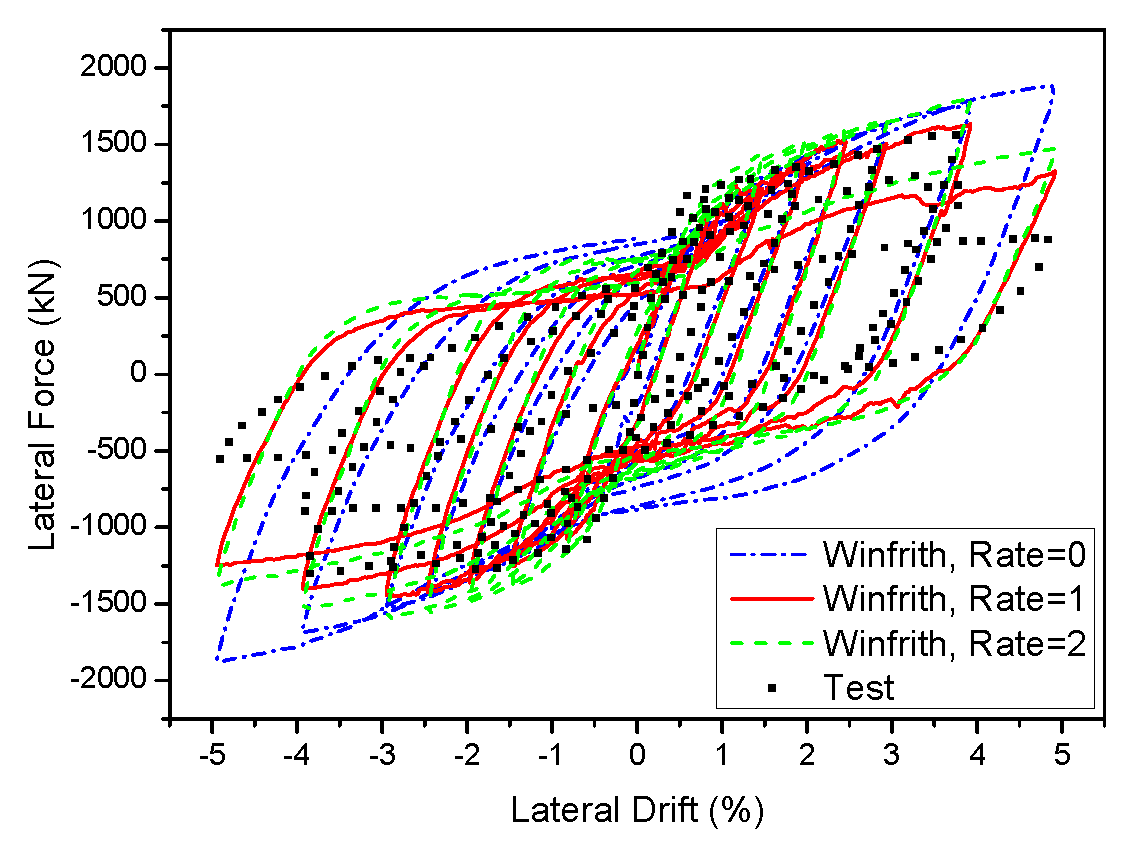
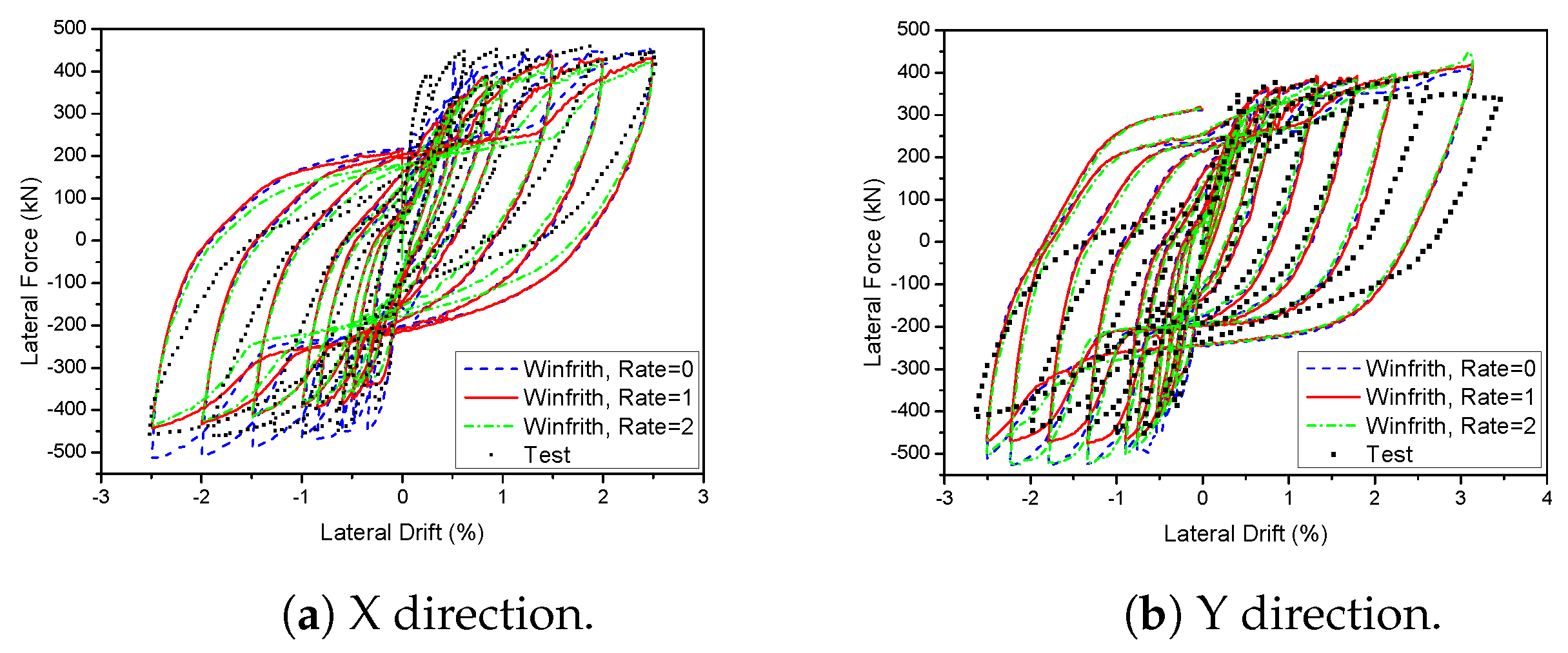
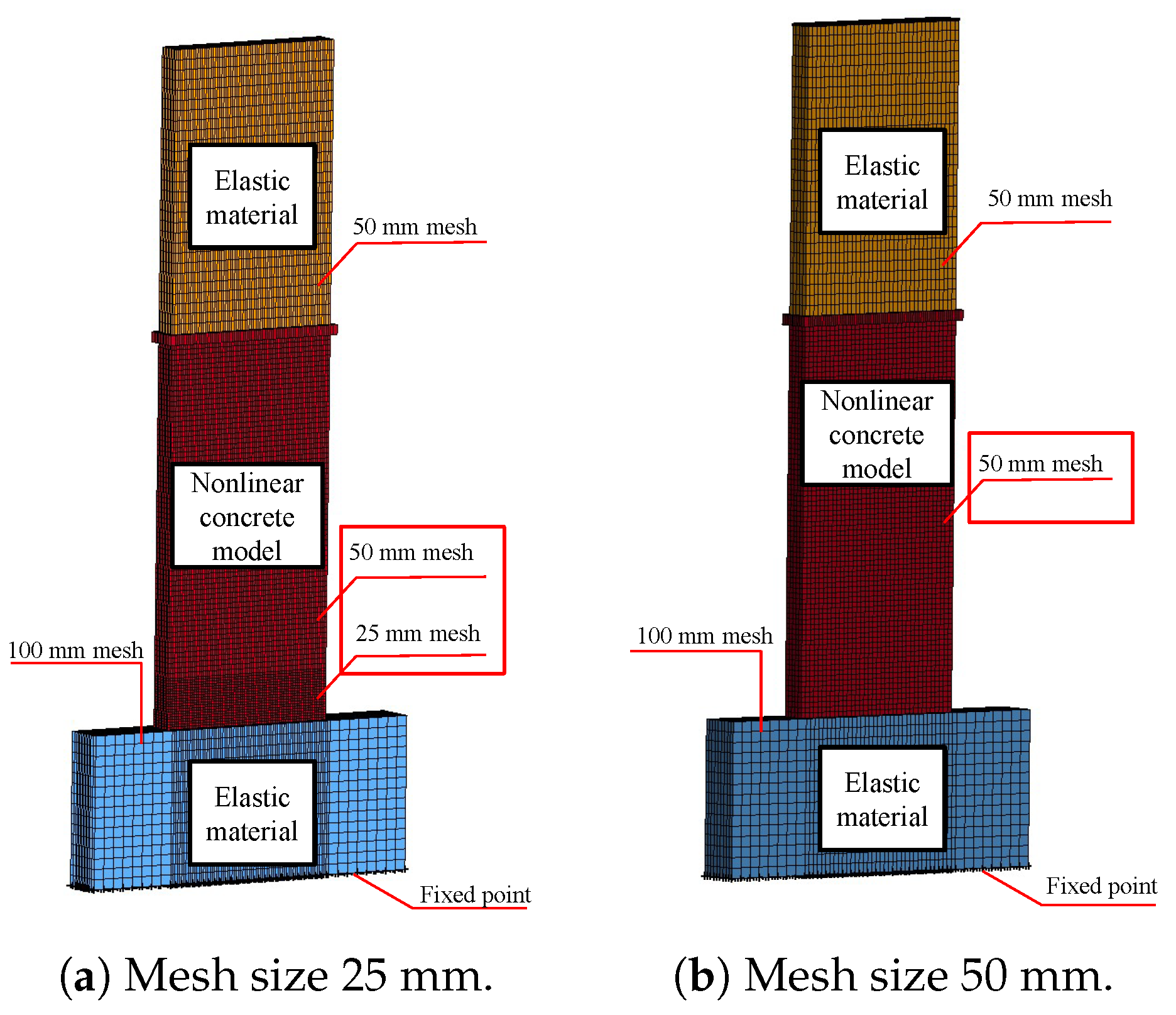
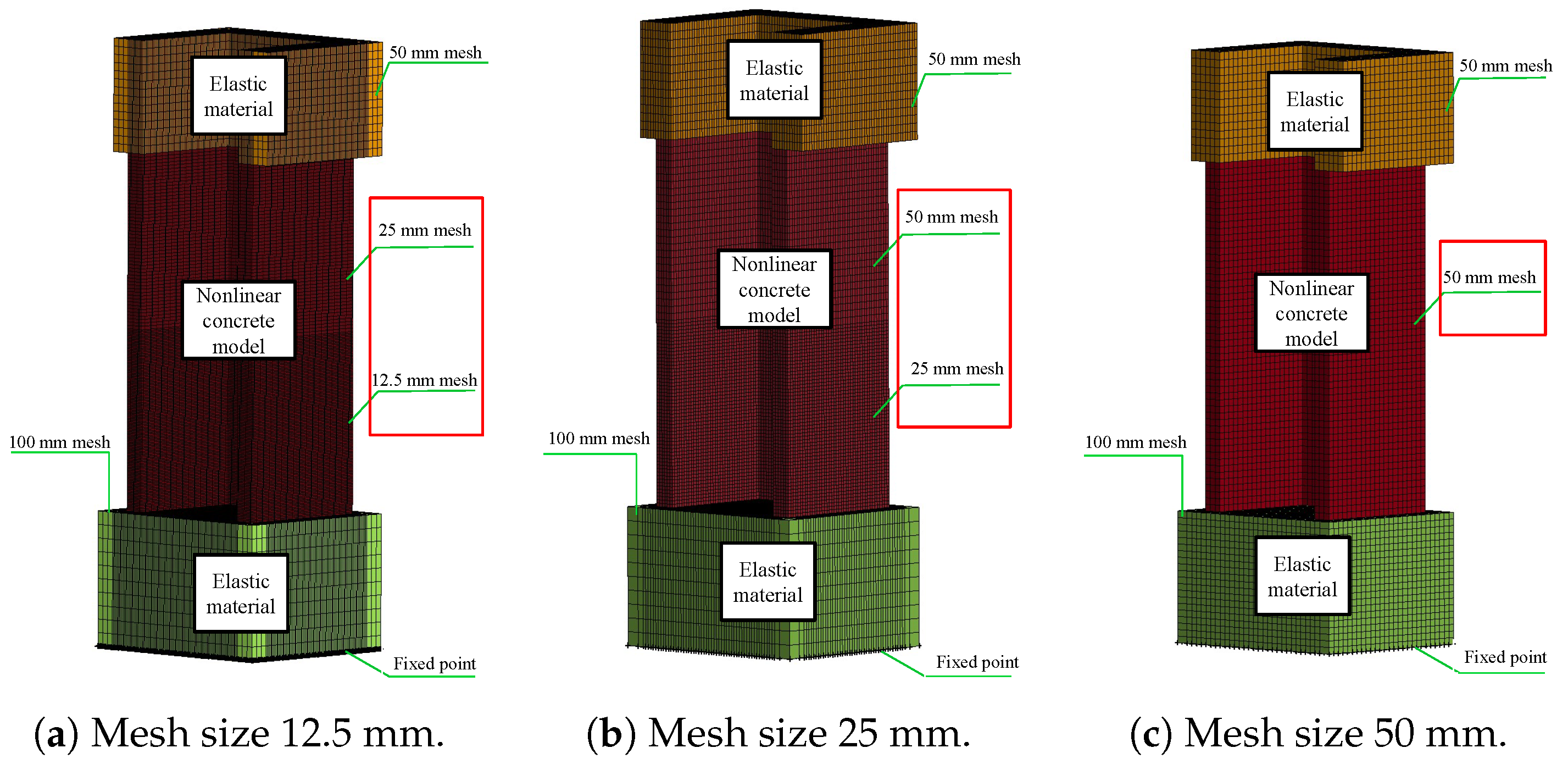
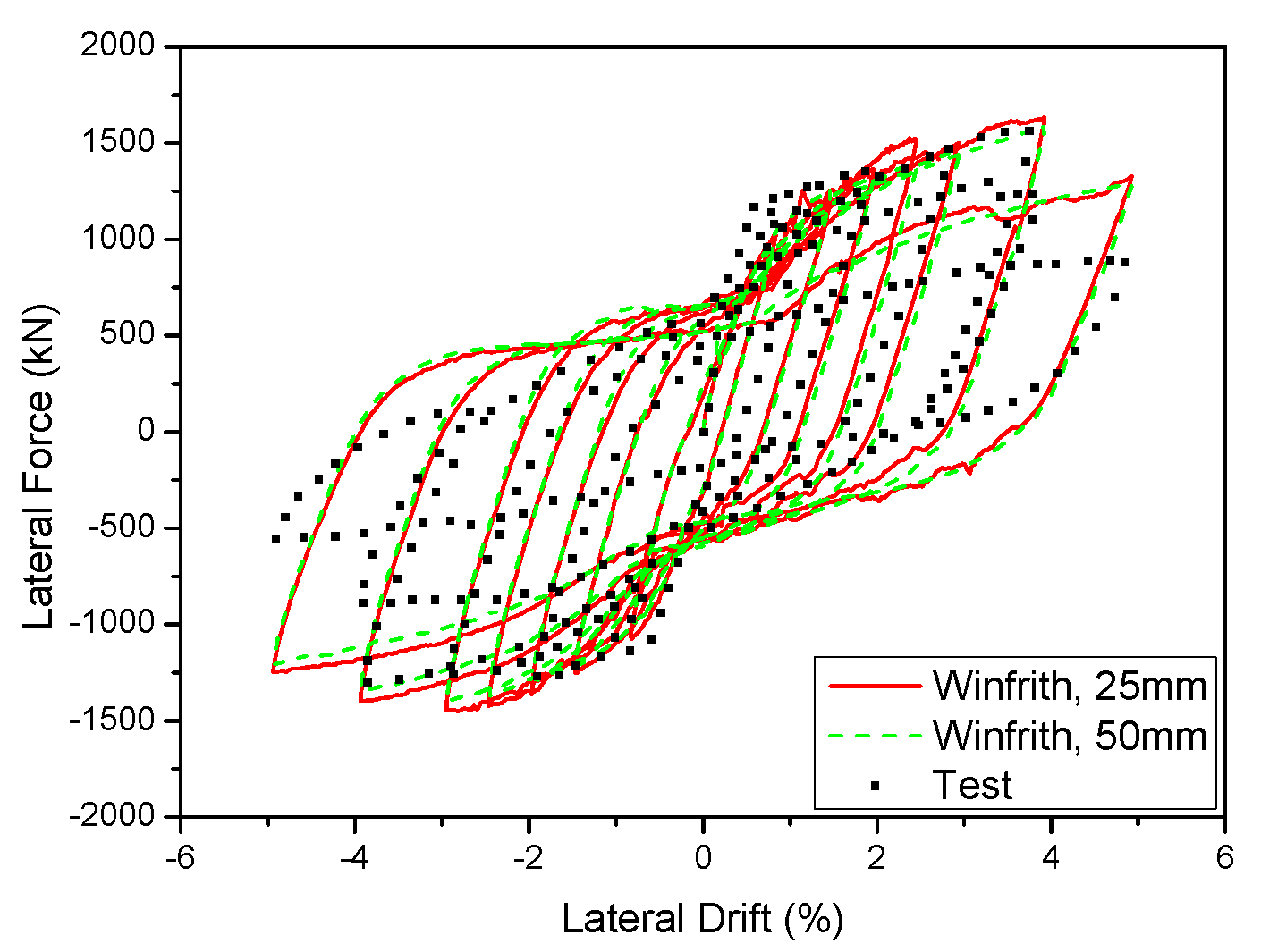

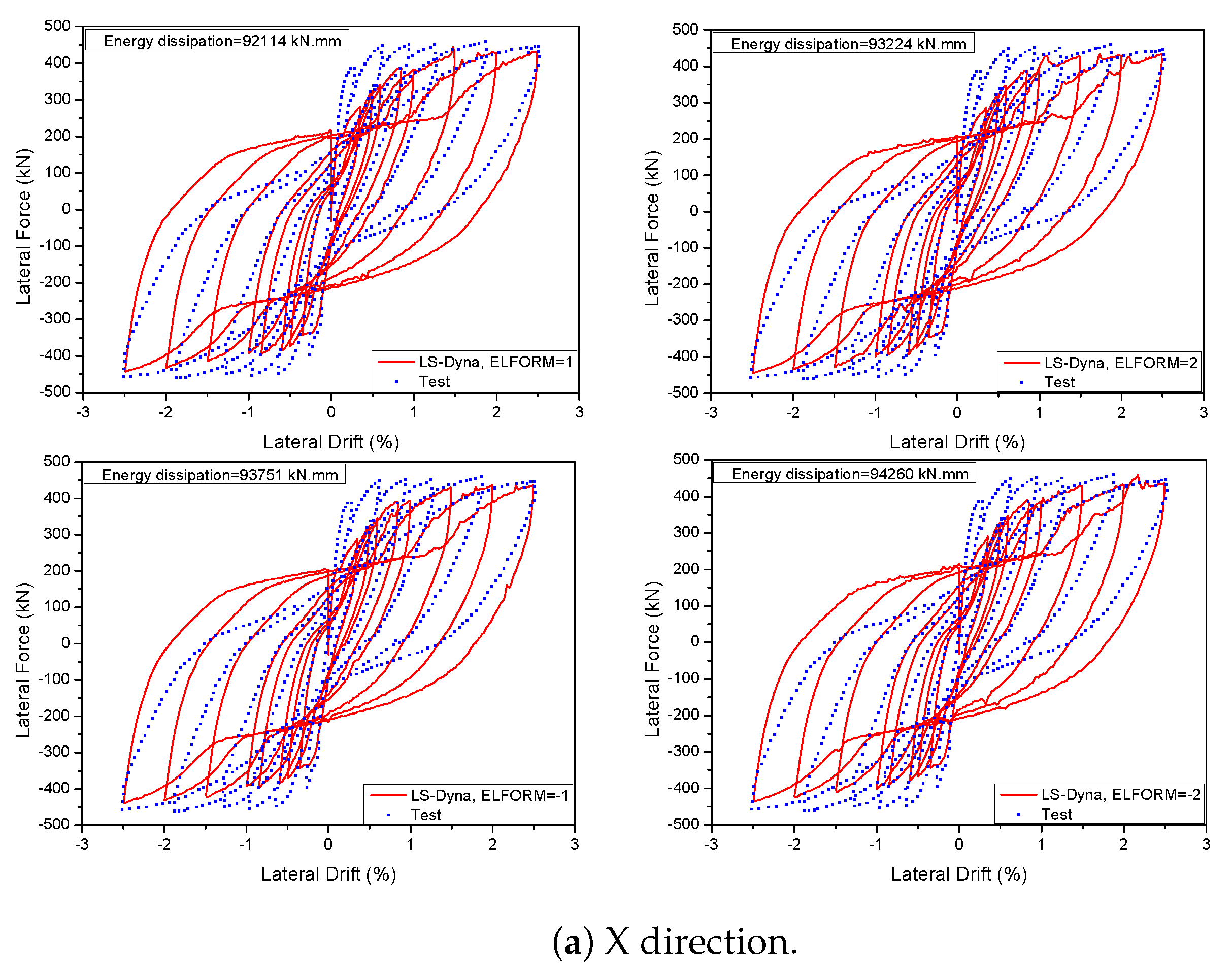

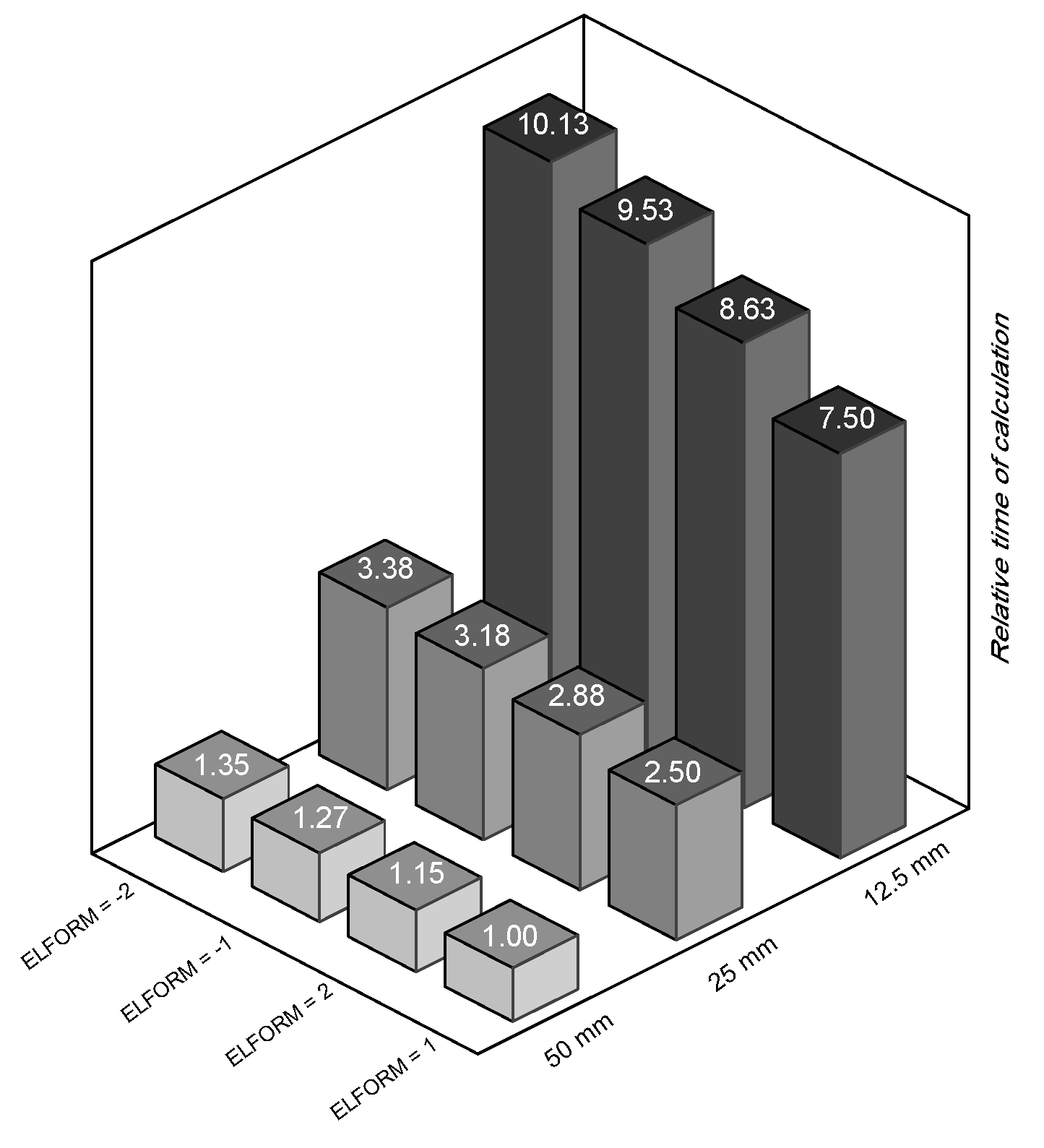
| Specimen | Concrete | Steel Reinforcements | ||||||
|---|---|---|---|---|---|---|---|---|
(MPa) | (g/mm3) | Bar Type | (MPa) | (g/mm3) | (MPa) | (MPa) | ||
| Pakiding et al. [45] 2D Wall | 43.4 | 0.0023 | #1 | 200,000 | 0.00783 | 0.3 | 519 | 744 |
| #2 | 200,000 | 0.00783 | 0.3 | 473 | 742 | |||
| #3 | 200,000 | 0.00783 | 0.3 | 473 | 742 | |||
| #4 | 200,000 | 0.00783 | 0.3 | 441 | 683 | |||
| #5 | 200,000 | 0.00783 | 0.3 | 1675 | 2038 | |||
| Beyer et al. [46] 3D Wall | 45 | 0.0023 | #6 | 200,000 | 0.00783 | 0.3 | 519 | 744 |
| #7 | 200,000 | 0.00783 | 0.3 | 518 | 681 | |||
| Material | Initial Stiffness (kN/mm) | Peak Strength (kN) | Energy Dissipation (kN.mm ) | |||
|---|---|---|---|---|---|---|
| Value | Error (%) | Value | Error (%) | Value | Error (%) | |
| Test | 57.74 | - | 1561 | - | 14,766 | - |
| KCC | 63.23 | 8.68 | 1640 | 4.82 | 25,321 | 41.69 |
| CDP | 73.5 | 21.44 | 1410 | −9.67 | 14,756 | 0.06 |
| Winfrith | 29.83 | −48.33 | 1720 | 9.24 | 20,532 | 28.08 |
| Material | Initial Stiffness (kN/mm) | Peak Strength (kN) | Energy Dissipation (kN.mm ) | |||
|---|---|---|---|---|---|---|
| Value | Error (%) | Value | Error (%) | Value | Error (%) | |
| Test | 49.69 | - | 459.01 | - | 85,809 | - |
| KCC | 36.98 | −25.58 | 392.26 | −14.54 | 66,353 | −22.67 |
| CDP | 51.25 | 3.04 | 469.84 | 2.31 | 49,437 | −42.44 |
| Winfrith | 37.74 | −24.05 | 443.97 | −3.28 | 92,114 | 6.84 |
| Material | Initial Stiffness (kN/mm) | Peak Strength (kN) | Energy Dissipation (kN.mm ) | |||
|---|---|---|---|---|---|---|
| Value | Error (%) | Value | Error (%) | Value | Error (%) | |
| Test | 29.66 | - | 452.06 | - | 106,027 | - |
| KCC | 27.05 | −8.8 | 386.01 | −14.61 | 101,223 | −4.53 |
| CDP | 27.11 | −8.6 | 434.87 | −3.81 | 98,357 | −7.23 |
| Winfrith | 21.69 | −26.87 | 475.95 | 5.02 | 127,165 | 6.62 |
| Concrete Strength (MPa) | Increasing Strength (%) | KCC Model | CDP Model | Winfrith Model | |||
|---|---|---|---|---|---|---|---|
| Load (kN) | Improvement (%) | Load (kN) | Improvement (%) | Load (kN) | Improvement (%) | ||
| 43.4 | - | 1545 | - | 1589 | - | 1642 | - |
| 54.3 | 25 | 1612 | 4.3 | 1634 | 2.8 | 1724 | 5.1 |
| 65.1 | 50 | 1680 | 8.7 | 1750 | 10.1 | 1812 | 10.4 |
| 86.8 | 100 | 1797 | 16.3 | 1891 | 19.1 | 1952 | 18.9 |
| Concrete Strength (MPa) | Increasing Strength (%) | KCC Model | CDP Model | Winfrith Model | |||
|---|---|---|---|---|---|---|---|
| Load (kN) | Improvement (%) | Load (kN) | Improvement (%) | Load (kN) | Improvement (%) | ||
| 45 | - | 368 | - | 455 | - | 446 | - |
| 56.3 | 25 | 379 | 3.1 | 471 | 3.5 | 461 | 3.3 |
| 67.5 | 50 | 395 | 7.3 | 491 | 7.9 | 482 | 8.1 |
| 90 | 100 | 410 | 11.4 | 517 | 13.6 | 503 | 12.8 |
| Concrete Strength (MPa) | Increasing Strength (%) | KCC Model | CDP Model | Winfrith Model | |||
|---|---|---|---|---|---|---|---|
| Load (kN) | Improvement (%) | Load (kN) | Improvement (%) | Load (kN) | Improvement (%) | ||
| 45 | - | 463 | - | 436 | - | 417 | - |
| 56.3 | 25 | 478 | 3.2 | 449 | 3 | 431 | 3.4 |
| 67.5 | 50 | 494 | 6.7 | 470 | 7.8 | 451 | 8.1 |
| 90 | 100 | 512 | 10.6 | 522 | 19.7 | 508 | 21.8 |
Disclaimer/Publisher’s Note: The statements, opinions and data contained in all publications are solely those of the individual author(s) and contributor(s) and not of MDPI and/or the editor(s). MDPI and/or the editor(s) disclaim responsibility for any injury to people or property resulting from any ideas, methods, instructions or products referred to in the content. |
© 2024 by the authors. Licensee MDPI, Basel, Switzerland. This article is an open access article distributed under the terms and conditions of the Creative Commons Attribution (CC BY) license (https://creativecommons.org/licenses/by/4.0/).
Share and Cite
To, Q.B.; Shin, J.; Kim, S.J.; Kim, H.-W.; Lee, K. Effective Prediction of Concrete Constitutive Models for Reinforced Concrete Shear Walls under Cyclic Loading. Materials 2024, 17, 1877. https://doi.org/10.3390/ma17081877
To QB, Shin J, Kim SJ, Kim H-W, Lee K. Effective Prediction of Concrete Constitutive Models for Reinforced Concrete Shear Walls under Cyclic Loading. Materials. 2024; 17(8):1877. https://doi.org/10.3390/ma17081877
Chicago/Turabian StyleTo, Quoc Bao, Jiuk Shin, Sung Jig Kim, Hye-Won Kim, and Kihak Lee. 2024. "Effective Prediction of Concrete Constitutive Models for Reinforced Concrete Shear Walls under Cyclic Loading" Materials 17, no. 8: 1877. https://doi.org/10.3390/ma17081877
APA StyleTo, Q. B., Shin, J., Kim, S. J., Kim, H.-W., & Lee, K. (2024). Effective Prediction of Concrete Constitutive Models for Reinforced Concrete Shear Walls under Cyclic Loading. Materials, 17(8), 1877. https://doi.org/10.3390/ma17081877







